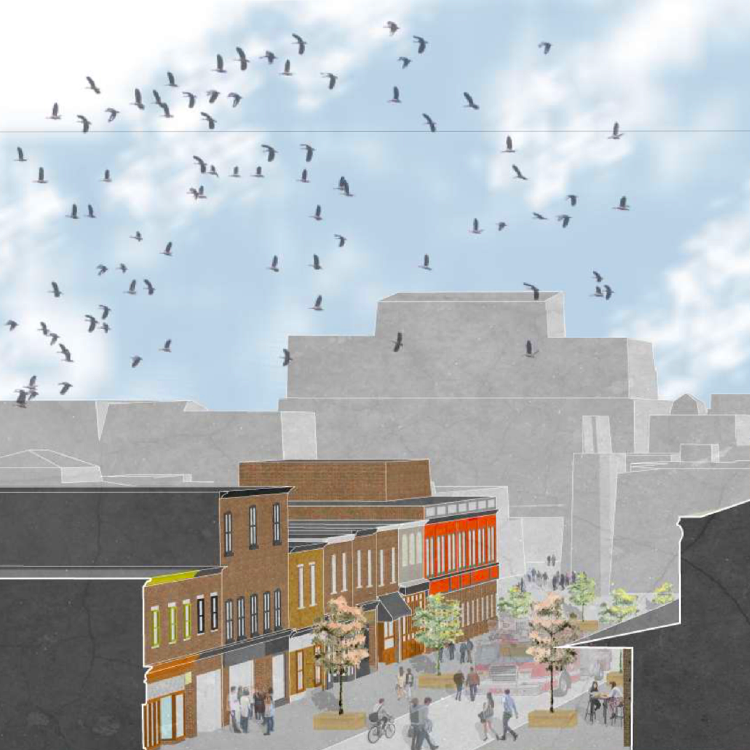Beyond functionality: how enhancing our built environment with beauty can help strengthen our sense of place

The built environment plays a big role in how we feel about our city. We may not realize it, but when we see beautiful buildings or bridges, let alone experience them by walking through or across them, it lifts our spirits.
Whether that’s the beautiful stonework of our heritage buildings or the shining innovations of our contemporary buildings, what we build, and how we build it, matters. In many cases, we have one chance to do a good job and leave a legacy that will last for generations.
A few years ago, construction work started on the Belfast maintenance yards for the LRT. Construction barriers on Belfast Road went up and fencing was dropped into place. When the LRT opened last summer, there was hope this would be replaced. Ugly, pre-cast, concrete barriers, which would be more at home on a highway construction site, remain in place. Cheap chain-link fences topped with barbed wire create an unwelcoming environment. What could have been a vital connection to the bike lanes on Coventry Avenue is a mess of broken or missing sidewalk and unrelieved ugliness. We went to the expense of replacing the 417 overpass and it is still too narrow for safe biking or walking. That overpass, like others nearby, is a once in a generation opportunity to improve infrastructure and, without it, access to Coventry Avenue is severely limited. A detour over the Max Keeping bridge nearby is handy if heading west, but if your destination is east, a pedestrian or cyclist is forced to take their lives in their hands.
Further east on Belfast, past more of the barbed wire-topped fence, cars park along the road in a dirt shoulder, despite a large parking lot for OC Transpo staff. It isn’t clear if these cars are here because of insufficient capacity in the parking lot, or for simple convenience. Either way, it creates a dangerous condition for all road users: the cars are very close to the road, creating a “dooring zone” for passing cyclists (Belfast is part of the City cycling route). Drivers who park have to walk on the road to get to the cheap asphalt sidewalk, often a long walk in winter as the snowplows bury this stretch of the unpaved shoulder. Cars may be parked here for hours and are often here even when the parking lot is empty.
Unloved and unlovable, this bit of infrastructure isn’t going to make or break our tourism industry. Belfast Avenue is, after all, a bit of a short cut through industrial lands connecting St. Laurent Blvd and Coventry Avenue. But it also connects the Trainyards mall, where intensification targets anticipate multi-family housing, as well as the residential communities of Eastway Gardens and the communities south of Coronation Avenue (Riverview area) with rapid transit. This street should be a vital link between General Urban and Urban Employment Areas, with a well-designed shoulder, safe road infrastructure, and a Multi-Use-Path that supports multi-modal transportation to and from rapid transit. If parking on the street is warranted, it should be metered to urge short term parking while visiting a business in the area.
The built environment needs to be uplifting. Significant funds were spent on the maintenance building offices and landscaping around the parking lot, but the rest of the infrastructure was given no thought.
Consider the humble air-vent; the one at the corner of Belfast and Tremblay is ugly, with poorly formed concrete and almost no care or attention to the detail of what this will look like for generations to come. Compare that with the air vent on the NRC campus which serves a very utilitarian function, yet is a beautifully crafted bit of industrial architecture that both functions and lifts the spirit. Beauty and purpose together.
Ottawa has lost the opportunity to deliver inspiring beauty in the humble function of its very necessary built form. Beauty has been discarded in favour of bare, short-term functionality. Thoughtlessness in planning infrastructure undermines our efforts to make a beautiful city.
The City of Edmonton recently won three Governor General Awards in Architecture. A quarter of these biannual awards went to one city. One of those projects was a humble stormwater treatment facility by gh3 architecture. Edmonton has put efforts into making necessary investments more meaningful for the people who have, are and will pay for this infrastructure.
Whether it is highway overpasses, pedestrian bridges, or LRT air vents, we have an obligation to enhance our built environment with beauty. The money we spend today on infrastructure must do more than meet a minimum threshold of short-term functionality; it must enhance our sense of place, deliver a sense of pride in our city, and show that we believe in leaving a legacy for future generations. Architecture matters.
Toon Dreessen is an architect and the president of the Ottawa-based practice Architects DCA. He is a past president of the Ontario Association of Architects.